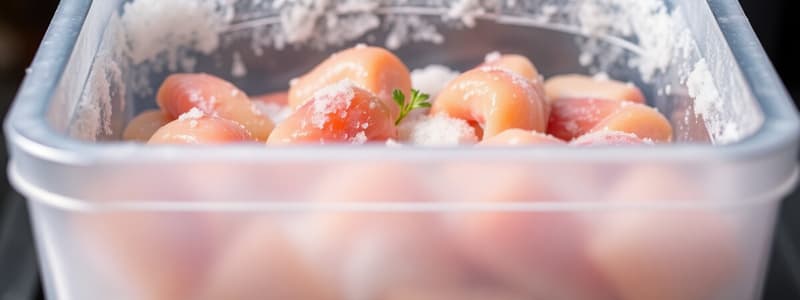Podcast
Questions and Answers
What is the primary purpose of freezing food?
What is the primary purpose of freezing food?
Which of the following is NOT considered a major group of commercially frozen foods?
Which of the following is NOT considered a major group of commercially frozen foods?
What type of heat is removed first when freezing food?
What type of heat is removed first when freezing food?
Why is the heat load important in food freezing?
Why is the heat load important in food freezing?
Signup and view all the answers
Which type of freezer uses a continuous cycle of evaporation and compression to cool food?
Which type of freezer uses a continuous cycle of evaporation and compression to cool food?
Signup and view all the answers
What temperature range do chest freezers typically operate in?
What temperature range do chest freezers typically operate in?
Signup and view all the answers
What is the role of latent heat in food freezing?
What is the role of latent heat in food freezing?
Signup and view all the answers
Which of the following statements about cryogenic freezers is true?
Which of the following statements about cryogenic freezers is true?
Signup and view all the answers
What is a primary issue associated with cold storage facilities?
What is a primary issue associated with cold storage facilities?
Signup and view all the answers
What temperature range is typically used in blast freezers?
What temperature range is typically used in blast freezers?
Signup and view all the answers
In fluidised-bed freezers, what is the purpose of passing high-velocity air through the product?
In fluidised-bed freezers, what is the purpose of passing high-velocity air through the product?
Signup and view all the answers
Which method is typically used to freeze products like ice cream?
Which method is typically used to freeze products like ice cream?
Signup and view all the answers
What is one common refrigerant used in cryogenic freezers?
What is one common refrigerant used in cryogenic freezers?
Signup and view all the answers
Which of the following is a disadvantage of slow freezing in food preservation?
Which of the following is a disadvantage of slow freezing in food preservation?
Signup and view all the answers
What effect does freezing have on vitamins in food?
What effect does freezing have on vitamins in food?
Signup and view all the answers
What ensures effective cooling and minimizes air bypassing in continuous freezing equipment?
What ensures effective cooling and minimizes air bypassing in continuous freezing equipment?
Signup and view all the answers
What is a characteristic of cooled-surface freezers?
What is a characteristic of cooled-surface freezers?
Signup and view all the answers
How does blast freezing differ from other freezing methods?
How does blast freezing differ from other freezing methods?
Signup and view all the answers
What method effectively minimizes large ice crystal formation while freezing products?
What method effectively minimizes large ice crystal formation while freezing products?
Signup and view all the answers
What is one major change to plant foods due to freezing?
What is one major change to plant foods due to freezing?
Signup and view all the answers
What is one benefit of using cryogenic freezing for smaller food items?
What is one benefit of using cryogenic freezing for smaller food items?
Signup and view all the answers
What common problem can arise during the storage of frozen foods?
What common problem can arise during the storage of frozen foods?
Signup and view all the answers
What change occurs in fruits due to freezing related to anthocyanins?
What change occurs in fruits due to freezing related to anthocyanins?
Signup and view all the answers
Study Notes
Freezing as a Unit Operation
- Freezing reduces food temperature below its freezing point, causing some water to form ice crystals.
- This immobilizes water and concentrates dissolved solutes, reducing water activity (aw).
- Preservation combines low temperatures, low water activity, and sometimes pre-treatments like blanching.
Types of Commercially Frozen Foods
- Fruits (whole, pureed, juice concentrates)
- Vegetables (peas, beans, corn, spinach, potatoes)
- Fish (fillets, seafood, fish fingers, cakes)
- Meats (beef, lamb, poultry, meat products)
- Baked goods (bread, cakes, pies)
- Prepared foods (pizzas, desserts, meals, ready-made dishes)
Freezing Theory
- Sensible heat is removed first to lower food to its freezing point.
- Respiratory heat (heat load) in fresh produce must also be removed.
- Significant energy is needed to remove latent heat and form ice crystals.
- Latent heat from other food components (e.g., fats) must also be removed.
Freezing Equipment
- Mechanical Refrigerators: Use refrigerant cycles (cooled air, liquid, or surfaces) to remove heat.
- Cryogenic Freezers: Use solid/liquid CO2, liquid nitrogen, or liquid Freon that directly contacts the food itself.
Cooled-Air Freezers
- Chest Freezers: Stationary air (-20ºC to -30ºC), slow freezing (3–72 hrs). Not suitable for commercial freezing.
- Blast Freezers: Recirculated air (-30ºC to -40ºC) at high velocity (1.5–6.0 m/s) to increase heat transfer. This is suitable for batch or continuous use, using trays or conveyor belts.
Fluidised-bed Freezers
- Modified blast freezers with high-velocity air (-25ºC to -35ºC) that circulates through the food bed.
- Sometimes, uses two stages (shallow bed for initial surface freezing, followed by deeper bed for complete freezing).
Cooled-Liquid Freezers
- Immersion: Packaged food is submerged in refrigerated propylene glycol, brine, glycerol, or calcium chloride on a conveyor. (less common now)
- Modern methods use refrigerant sprayed directly onto food.
Cooled-Surface Freezers
- Plate Freezers: Hollow plates with refrigerant at -40ºC, for flat foods (fish, burgers). May be batch, semi-continuous, or continuous.
- Foods are placed between plates; slight pressure is applied.
Scraped Heat Exchangers
- Used to freeze items like ice cream, to mix and freeze simultaneously and reduce large ice crystal formation.
Cryogenic Freezers
- Utilize a change of state in the refrigerant (cryogen) to rapidly remove heat from the food.
- High heat transfer coefficients, rapid freezing.
- Liquid nitrogen and solid/liquid CO2 are common cryogens.
Cryogenic Freezing
- Liquid nitrogen or CO2 is sprayed directly onto food (soft fruits, prawns).
- Nitrogen gas is removed, CO2 is more economical and recyclable.
Changes in Frozen Foods
- Effect of Freezing: Cell damage from ice crystal growth is the main impact on quality. Pigments, flavor, and nutritionally important components are not much affected during freezing.
- Plant Tissues: Slow freezing damages plant cells more than fast freezing.
- Storage: Pigment degradation (chlorophyll to pheophytin), pH changes affecting anthocyanins, and loss of water-soluble vitamins (vitamin C, pantothenic acid) occurs over time and the rate depends on temperature.
Studying That Suits You
Use AI to generate personalized quizzes and flashcards to suit your learning preferences.
Description
Explore the science and techniques behind freezing as a unit operation in food preservation. Learn about the types of commercially frozen foods, freezing theory, and the equipment used in the process. This quiz will test your understanding of how freezing impacts food safety and quality.




